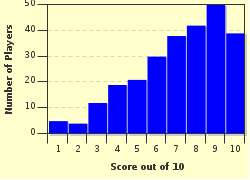Quiz Answer Key and Fun Facts
1. One of the earliest controversies in cricket was 'Bodyline'. The English cricket team in the 1932-33 tour of Australia bowled bouncers on the leg stump, stunning the Australian batsmen and the world of cricket. Who was the mastermind of the bodyline theory?
2. Racism has been an ugly word in the world of cricket. The South African government which practiced apartheid was allowed to play international cricket till the early 1970s when they were finally isolated. What event triggered this isolation?
3. The World Series Cricket (WSC) was a rebel cricket league started by Kerry Packer in the mid-1970s, which shook the world of cricket by introducing day/night matches, helmets and coloured clothing. Why did Packer start World Series Cricket?
4. In 1981, in a one day match between Australia and New Zealand, New Zealand needed a six off the last ball to tie the match. Australian skipper Greg Chappell asked the bowler to bowl an underarm delivery (along the grund) for the last ball of the match, creating a furore. Who was the bowler who bowled the infamous underarm delivery?
5. One of the major controversies involving cricket umpires took place in the 1987 England tour of Pakistan, when umpire Shakoor Rana had an ugly on-field spat with the English cricket captain and also boycotted the match by refusing to officiate. Who was the English cricket captain involved in this controversy?
6. The biggest and most shameful controversy to affect cricket has been the match-fixing controversy. In late 2000 the captains of three nations were found guilty and banned. Which was the country whose captain was NOT affected by this scandal?
7. Muttiah Muralitharan is considered as not only the greatest off-spinner, but also the most controversial. In 1995 in the Boxing day test in Australia, he was called for throwing by an on-field umpire, creating a controversy. Who was the umpire who no-balled Murali seven times in the match for throwing?
8. The test match in Antigua between Australia and West Indies in 2003, witnessed an ugly on-field spat between an Australian and a West Indian. This incident shocked the cricketing world and forced the ICC to introduce a code a conduct for players. Who were the two players involved in this controversy?
9. The August 2006 match between England and Pakistan saw a ball tampering controversy, which later led to the match being awarded to England (as Pakistan refused to finish playing the match). Who were the two umpires involved in this incident?
10. The 2007 World cup was held in the West Indies and was highly controversial with the shocking first round exits of India and Pakistan. What shook the world was the mysterious death of Bob Woolmer. Which team did Woolmer represent in the world cup?
Source: Author
deepakmr
This quiz was reviewed by FunTrivia editor
gtho4 before going online.
Any errors found in FunTrivia content are routinely corrected through our feedback system.

